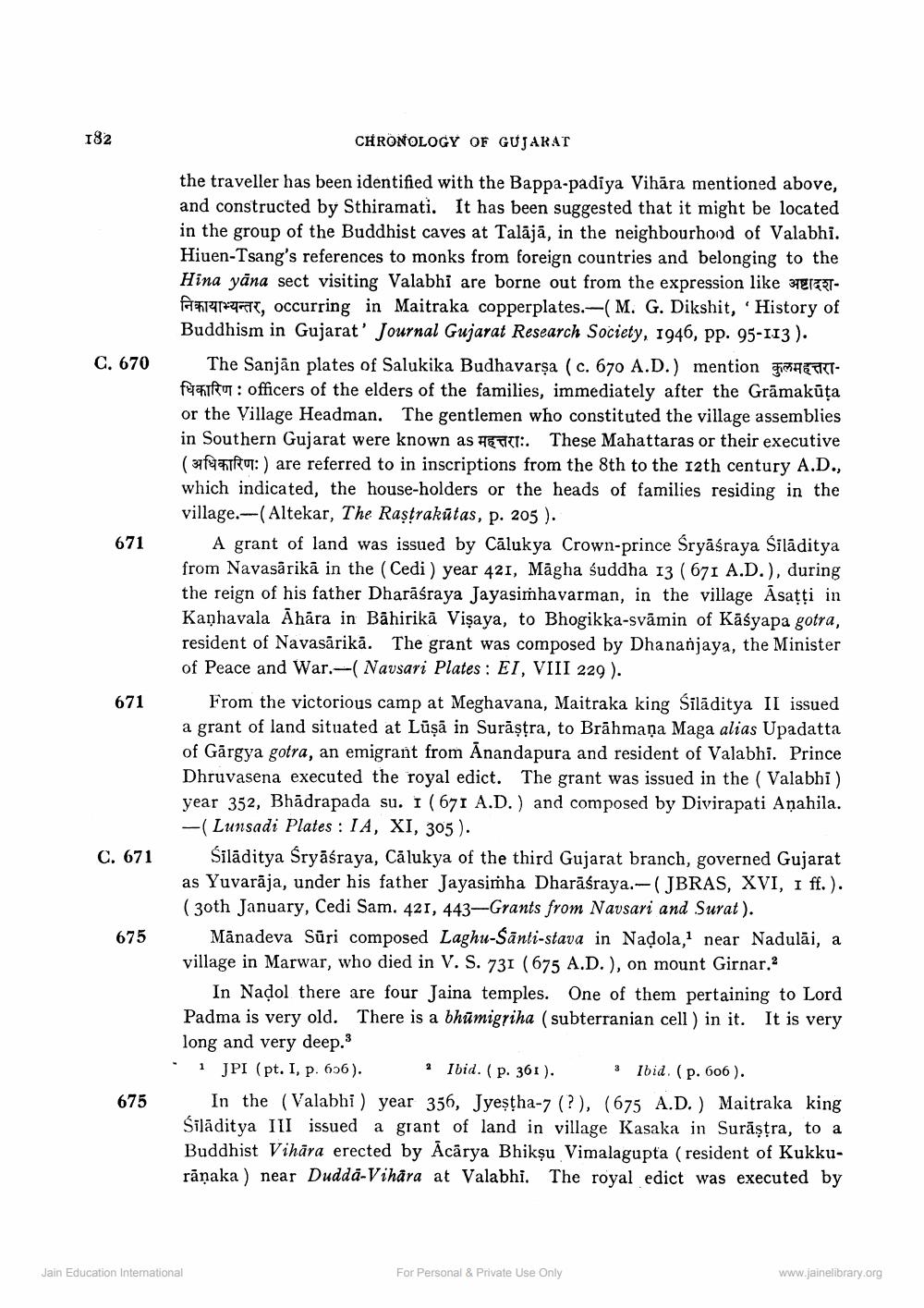________________
182
C. 670
671
671
C. 671
675
675
CHRONOLOGY OF GUJARAT
the traveller has been identified with the Bappa-padiya Vihara mentioned above, and constructed by Sthiramati. It has been suggested that it might be located in the group of the Buddhist caves at Taläjä, in the neighbourhood of Valabhi. Hiuen-Tsang's references to monks from foreign countries and belonging to the Hina yana sect visiting Valabhi are borne out from the expression like
-
, occurring in Maitraka copperplates.-M. G. Dikshit, History of Buddhism in Gujarat' Journal Gujarat Research Society, 1946, pp. 95-113).
The Sanjan plates of Salukika Budhavarsa (c. 670 A.D.) mention g##LIKTfast: officers of the elders of the families, immediately after the Gramakūta or the Village Headman. The gentlemen who constituted the village assemblies in Southern Gujarat were known as H. These Mahattaras or their executive (af) are referred to in inscriptions from the 8th to the 12th century A.D., which indicated, the house-holders or the heads of families residing in the village. (Altekar, The Raṣṭrakūtas, p. 205).
A grant of land was issued by Calukya Crown-prince Sryâśraya Siladitya from Navasarika in the (Cedi) year 421, Magha śuddha 13 (671 A.D.), during the reign of his father Dharâśraya Jayasimhavarman, in the village Åsaṭṭi in Kanhavala Åhara in Bähirika Visaya, to Bhogikka-svåmin of Kasyapa gotra, resident of Navasärikā. The grant was composed by Dhananjaya, the Minister of Peace and War.-( Navsari Plates: EI, VIII 229).
From the victorious camp at Meghavana, Maitraka king Ślläditya II issued a grant of land situated at Lüşă in Surăştra, to Brahmana Maga alias Upadatta of Gárgya gotra, an emigrant from Anandapura and resident of Valabhi. Prince Dhruvasena executed the royal edict. The grant was issued in the (Valabhi) year 352, Bhadrapada su. 1 (671 A.D.) and composed by Divirapati Anahila. -(Lunsadi Plates: IA, XI, 305).
Siladitya Sryasraya, Calukya of the third Gujarat branch, governed Gujarat as Yuvaraja, under his father Jayasimha Dharāśraya.-(JBRAS, XVI, 1 ff.). (30th January, Cedi Sam. 421, 443-Grants from Navsari and Surat).
Månadeva Suri composed Laghu-Santi-stava in Nadola, near Nadulai, a village in Marwar, who died in V. S. 731 (675 A.D.), on mount Girnar.
In Nadol there are four Jaina temples. One of them pertaining to Lord Padma is very old. There is a bhümigrika (subterranian cell) in it. long and very deep."
1 JPI (pt. I, p. 656).
Ibid. (p. 361).
Ibid. (p. 606).
In the (Valabhi) year 356, Jyestha-7 (?), (675 A.D.) Maitraka king Šiladitya III issued a grant of land in village Kasaka in Suraṣṭra, to a Buddhist Vihara erected by Acarya Bhiksu Vimalagupta (resident of Kukkurapaka) near Dudda-Vihara at Valabhi. The royal edict was executed by
Jain Education International
For Personal & Private Use Only
3
www.jainelibrary.org




